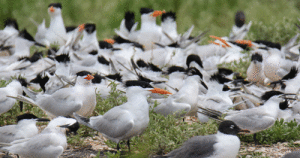Some of the most colorful parts of the English language are the many beloved sayings and popular adages that have emerged over time. Many seem to be burned into my brain, and I reflexively recall that “watched pots never boil” and that “even broken clocks are right twice a day” whenever applicable. Sayings like these are often well-known and well-used throughout the language and usually have deeper meanings past their literal interpretations.
Adages come and go, but the ones that stay around usually use common imagery and relatable themes and experiences to comment on important life lessons. One notable inspiration for many enduring expressions is the natural world, particularly birds, whose traits, behaviors, and charisma have made them the subject of many age-old sayings.
“The early bird gets the worm” is one of the most famous bird-related sayings still used today! The phrase, first used in 1605, suggests that a bird that wakes up the earliest has the best chance of catching a good breakfast. Similarly, it implies that individuals who start first or earlier than others have more opportunities than those who wait.
There is truth in this saying, as birds often compete against one another for the best food, habitats, and mates. Additionally, the famous worm-loving American Robin is one of the earliest waking birds, and they wake and begin singing well before the sun rises. And sure enough, it’s the Robins who make it to the dew-covered, earthworm-packed soil first. Robins can eat 20 worms per hour and have been seen eating up to 14 feet of earthworm a day!
One less popular (although just as witty) saying is, “Opportunity is a bird that never perches.” This adage implies that opportunities in life are always in motion and won’t stop to be captured. While the avian imagery effectively conveys an important lesson, the reality is that birds eventually need to perch or stop to rest!
While warbler-weary birders may insist that the little birds never stop moving, there are no species of bird that can be in motion indefinitely… However… Some birds can fly for a very long time. One such species is the Gulf Coast’s Magnificent Frigatebird, which can stay aloft in the air for up to 2 months! With their nearly 8-foot wingspan, they can fly without expending much energy and even catch up on sleep while in the air.
If you were to see a group of art students walking down the street, one might mention that “birds of a feather flock together.” The phrase suggests that individuals with similar goals, personalities, and interests naturally stick together, much like birds of the same species form large flocks. And if you’ve ever seen a large flock of wading birds near the beach or gulls in a store parking lot, you’d know that the saying is relatively true!
Many species of birds form large flocks with other individuals of their species. Being in a flock has many advantages, such as increased protection from predators and more efficient migration. Flocking isn’t only reserved for individuals of a single species. Sometimes, mixed flocks form where individuals of many different species forage together and benefit from the safety of increased vigilance. whether it’s lessons about the benefits of waking up early, encouragement to pursue our flighty dreams, or a reminder to stick close to our flock of friends. As these age-old adages continue, they remind us of the lessons that we can learn by simply observing nature.
Photo credit: Alan Wilde
Caption: Gulls and terns, birds of a feather, often for large flocks together.
These bird-inspired sayings remind us how closely the lessons of our lives mirror the natural world around us. Birds provide familiar imagery that we can relate to and learn from, whether it’s lessons about the benefits of waking up early, encouragement to pursue our flighty dreams, or a reminder to stick close to our flock of friends. As these age-old adages continue, they remind us of the lessons that we can learn by simply observing nature.

